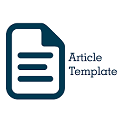Zonasi Kerentanan Kekeringan dan Rekomendasi Perlindungan Daerah Imbuhan dan Mataair Lotong lotong, Kabupaten Bulukumba, Sulawesi Selatan
Abstract
ABSTRACT
Drought is a problem that is vulnerable to occur in Indonesia, and is always associated with decreasing quality (degradation) of the environment / characteristics or conditions of an area. The Lotong-lotong area, Bulukumba is an area on a mountainside and has high draught potential, and also the low quality of the ground and surface water. The occurrence of drought in the Lotong-lotong area, Bulukumba is basically controlled by geophysical-chemical components such as landforms, soil, and rocks and is triggered by components such as land use. The purpose of this study is to determine the zone affected by drought and recommendations for its management later. The problem of drought in Lotong-lotong, Bulukumba, if not handled properly will affect the lives of many people.
The method used in the effort to deal with drought in Lotong-lotong, Bulukumba uses various field data, especially geophysical data. The data taken is then plotted and analyzed using a GIS overlay. Geophysical mapping carried out in the affected area aims to determine the geophysical factors that cause drought.
The results of the mapping show that drought in the affected area involved several factors, namely rock and weathering results, soil texture, steep slope and quite thick and deep vadose zone thickness. In terms of design, geophysical information from the field mapping results will be used to design the location and design of water reservoirs to overcome drought in the affected area in Lotong-lotong, Bulukumba, and also to gain detailed information about pollutant source that affected quantity and quality.
Keywords: Drought, lithology, soil, slope, ground water carrier zone.
ABSTRAK
Kekeringan adalah suatu permasalahan yang rentan terjadi di Indonesia, dan selalu dikaitkan dengan terjadinya penurunan kualitas (degradasi) lingkungan / karakteristik ataupun kondisi suatu daerah. Daerah Lotong-lotong, Bulukumba merupakan daerah yang berada di lereng gunung dan memiliki potensi terjadinya bencana kekeringan dan juga kualitasnya yang tidak standar. Terjadinya kekeringan di daerah Lotong-lotong, Bulukumba pada dasarnya dikontrol oleh komponen-komponen geofisik-kimia seperti bentuk lahan, tanah, dan batuan dan dipicu oleh komponen-komponen seperti penggunaan lahan. Tujuan dari penelitian ini adalah untuk menganalisis rona lingkungan daerah penelitian, menganalisis potensi (kuantitas dan kualitas) mataair Lotong Lotong, dan menganalisis tingkat pencemaran Mata Air Lotong Lotong
Metode yang digunakan dalam upaya penanggulangan kekeringan di Lotong-lotong, Bulukumba menggunakan berbagai data lapangan terutama data-data geofisik. Data-data yang diambil kemudian diplot dan dianalisis menggunakan overlay GIS. Pemetaan geofisik yang dilakukan di daerah terdampak bertujuan untuk mengetahui faktor-faktor geofisik penyebab-penyebab kekeringan.
Hasil pemetaan memperlihatkan bahwa kekeringan di daerah terdampak melibatkan beberapa faktor yakni batuan dan hasil pelapukannya, tekstur tanah, kemiringan lereng yang cukup curam dan ketebalan zona vadose (aeration) yang cukup tebal dan dalam. Dari segi perancangan, informasi-informasi geofisik hasil pemetaan lapangan ini akan digunakan untuk merancang lokasi dan desain penampungan air untuk mengatasi kekeringan di daerah terdampak di Lotong-lotong, Bulukumba, serta menggali informasi mengenai sumber pencemar yang sekiranya akan mempengaruhi jumlah (kuantitas dan kualitas) air yang ada.
Keywords
Full Text:
PDF (Bahasa Indonesia)References
Chen, C. (2017). Science Mapping: A Systematic Review of the Literature. Journal of Data and Information Science, 2(2), 1–40. https://doi.org/10.1515/jdis-2017-0006
Gao, T., Shen, L., Shen, M., Liu, L., & Chen, F. (2016). Analysis of material flow and consumption in cement production process. Journal of Cleaner Production, 112(August), 553–565. https://doi.org/10.1016/j.jclepro.2015.08.054
IPCC. (2012). Renewable energy sources and climate change mitigation: special report of the Intergovernmental Panel on Climate Change. In Renewable energy sources and climate change mitigation: special report of the Intergovernmental Panel on Climate Change. https://doi.org/10.5860/CHOICE.49-6309
Khoo, H. H. (2009). Life cycle impact assessment of various waste conversion technologies. Waste Management, 29(6), 1892–1900. https://doi.org/10.1016/j.wasman.2008.12.020
McDougall, F., White, P. R., Frankie, M., & Hindle, P. (2002). Integrated Solid Waste Management: A Life Cycle Inventory. In Waste Management (Second edi, Vol. 22). https://doi.org/10.1016/s0956-053x(02)00032-6
Moayedi, H., Salleh, Z. K., Huat, B. B. K., Yunus, M. F. B. M., Moayedi, F., & Moghaddas, M. (2011). Surface water treatment process; A review of various methods. Electronic Journal of Geotechnical Engineering, 16 G(December 2014), 753–761.
Nilson, L. (2007). The Environmental Management Book Series Cleaner Production – Technologies and Tools for Resource Efficient Production. In Environmental Management (Second, p. 326). Stockholm, Sweden Per: The Baltic University Press.
SAATY. T., 1993. Pengambilan Keputusan Bagi Para Pemimpin, Proses Hirarki Analitik untuk Pengambilan Keputusan dalam Situasi yang Kompleks, Pustaka Binama Pressindo.
SAATY, Thomas L.1993. The Analytical Hierarchy Process, mc Graw Hill, New York
WHO. (2019). National systems to support drinking-water, sanitation and hygiene: global status report 2019. UN-Water global analysis and assessment of sanitation and drinking-water (GLAAS) 2019 report.
DP. (2018). 08 Mei 2020, https://perpamsi.or.id/berita/view/2018/07/11/517/konsep-1000100-tidak-serumit-yang-dibayangkan
DOI: https://doi.org/10.31315/jilk.v3i2.3445
DOI (PDF (Bahasa Indonesia)): https://doi.org/10.31315/jilk.v3i2.3445.g3358
Refbacks
- There are currently no refbacks.
Copyright (c) 2021 Jurnal Ilmiah Lingkungan Kebumian

This work is licensed under a Creative Commons Attribution 4.0 International License.
Editorial Office;
Program Studi Teknik Lingkungan, Fakultas Teknologi Mineral, UPN “Veteran” Yogyakarta.
Jl. SWK 104 (Lingkar Utara) Condongcatur, Sleman, Yogyakarta 55283
Telp./ Fax. (0274) 486400, Email:jurnaltl@upnyk.ac.id

Jurnal Ilmiah Lingkungan Kebumian is licensed under a Creative Commons Attribution 4.0 International License.







